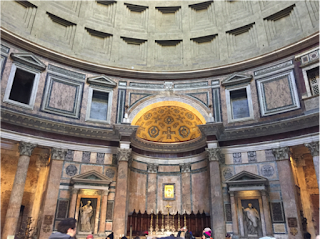Gentle Readers,
This blog post was written by the incomparable Nicole Curcio and Amanda Lee.
The Pantheon seen today is
one of Rome’s most widely known temples, dedicated pan theos, which means “all of the gods.” The Pantheon was built
between 118 and 125 AD. The temple was originally built by Marcus Agrippa but
then replaced by Domician after Agrippa’s pantheon was burned to the ground.
Finally, Trajan started the Pantheon seen today, but Hadrian completed it.
Hadrian almost never included his name on buildings he created, which is why
today the Pantheon still has Marcus Agrippa’s name on it. (Rome: An Oxford Archeological Guide by Amanda Claridge).
 |
| Pantheon with Inscription, which Reads, "M. Agrippa...built this" |
One of the most important
architectural features in the Pantheon is the several arches used to support
the famous dome. One of the major arches used is the relieving arch. There are
many weak spots due to the structure of the dome, so they are used to distribute
the weight of gravity evenly to keep the weight from focusing in one place and
crumbling the dome. This is especially important considering that within the
rotunda, there are eight places when stone is more fortified for the stressors
of the dome. This feature allows structures
like the Pantheon to stay standing while keeping the general structure wanted
as it does not change the dome shape and is not always clearly seen. Because of
these reliving arches, the rotunda can be open without any other weight bearing
structures inside of the rotunda except for the outside walls. Inside of the rotunda
is extremely large and is equal in length and height, creating a perfect
sphere. (Rome and Environs: An
Archeological Guide by Filippo Coarelli)
The engineers of the
Pantheon also dealt with the weight by changing the aggregate and making it
lighter as you go up the dome. The first layer is made of travertine, then a
mixture of tufa and travertine, and completed with pumice at the top. Other
materials, such as concrete were used for the foundation of the Pantheon. For
decorative effects, the rotunda was once coated in white stucco, which was used
to resemble expensive marble. Other decorative effects were used such as bronze
doors leading into the building, weighing up to twenty tons. The famous oculus
is also the only source of natural light, which is larger than it seems at
twenty-seven feet in diameter.
 |
| Famous Dome with the "Oculus," or "Eye," which lets light in. |
The pediment front is
supported on monolithic shafts made of Egyptian granite, bases and capitals
made of white Greek (Pentelic) marble. These structures were once coated in
stucco to give a marble effect without needing the use marble.
Reentrant architecture was
seen in the rotunda of the Pantheon. This is when there are alternating circle
and square decorum. Reentrant architecture was big in ancient roman
architecture because it added to the contrasting décor of the structures. This
approach at unique architecture was also seen in Trajan’s market and basilica’s
found in the Roman Forum. The marble seen on the floor below is a mixture of
white, red, yellow, and grey/black marble.
 |
| The floor of the Pantheon, utilizing re-entrant architecture technique with different colored marbles. |
Because the Pantheon was
built in a polytheistic religious era, there are statues of many gods
throughout the temple and it had a pagan affiliation. Because of this, when
Christianity became the religion in Rome, the Pantheon was then abandoned. The
decree of 408 ordered temples to be reused, which is why the Pantheon is in the
great state that it currently is. Despite the pagan affiliation, in 609 AD, the
Pantheon was consecrated into a Christian church. It is now dedicated to VirginMary and all of the martyrs.
 |
| Interior of Pantheon with modern decoration. |
No comments:
Post a Comment